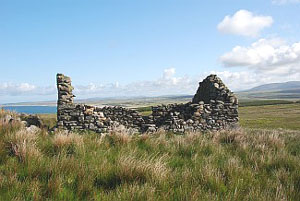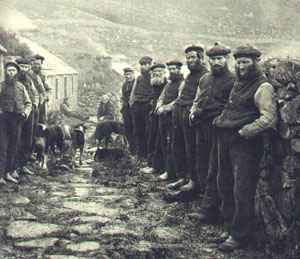| |
| |
|
The Patterns of
the Highland Clearances - Part 2 |
|
by
Ewan J. Innes, MA (Hons Scot. Hist.) FSA
Scot |
|
|
|
The flow of emigrants was
constant and relentless. Much of this was to blame on the increasing
population pressures in the Highlands and Islands. The growth of the kelp
industry had encouraged landowners to subdivide the crofts and insist on
large families. Consequently when the kelp industry collapsed and the price
of cattle fell there were now large numbers of surplus and destitute people
unable to pay either their rent or for their subsistence. The failure of the
potato crop, upon which the crofters were solely dependent, in the late
1830s and again in the 1840s and '50s was the last straw for many of these
people. |
|
The 'clearances' of the
1840s and early 1850s were intended to clear the land of those people who
were so destitute that the landlords could not support them. It was thought
that they would have a far better chance of surviving outside Scotland than
by staying at home.
This last wave of clearances was paid for by the landowners who found it
cheaper to pay for the transport of their tenants across the Atlantic or
even to the new favourite for émigrés, Australia. In many cases the tenants
had no choice but to emigrate, their homes having been torn down to make way
for sheep-walks. With nowhere left to go, the offer of passage to the
colonies where they would be able to acquire land denied to them in Scotland
was the only choice. |
| |
 |
| |
A Derelict Highland
Cottage abandoned in the 1800's |
|
|
The majority of Highlanders
did not emigrate however, many being too poor in the first place. Once the
break had been made with their land, many Gaels moved south to find work in
the factories of Lowland Scotland. By 1851 85,400 native born Highlanders
were living in the rest of Scotland However, all of this demographic
movement from the Highlands was not sufficiently fast enough to relieve the
pressure on the resources of the Highlands until well into the 1850s.
By the 1850s the Clearances were effectively at an end, for several reasons,
firstly there were no more people to evict, secondly the population had
finally begun to decrease, thirdly the economy was now beginning to pick up
and finally the fishing industry was finally entering an upturn. Moreover
the crofters were finally beginning to stir themselves on their own behalf.
The final end to clearances
came in 1886 with the passing of the Crofters Act after four years of
struggle. There are several reasons to explain why it took a long time for
the Highlanders to defend themselves. Firstly, they were slow to organise
effectively. Secondly, protests against the clearances tended to be
spontaneous and unorganised. Then the loss of their traditional leaders, the
Tacksmen, meant that they took time to recover from the shock of the
clearances, the destruction of the Clan society and also to produce new
leaders from amongst themselves. Finally the church had an important
influence on the course of events. The Church had tended to portray the
clearances as God's retribution for their sins on earth and they
consequently advised against protesting. This is a graphic example of the
effect the reintroduction of patronage had in Scotland. |
 |
|
|
Men in St Kilda prior
to their removal |
|
|
St Kilda was eventually
evacuated in the 1930's as the islanders were facing such hardship. Note
the men in this picture are all in bare feet. |
|
|
The question of patterns to
the clearances is difficult to explain. While the individual acts of
clearances showed differing characteristics there were several aspects which
remained the same in each case. The first of these is that of the economy.
The landowners were faced with a situation where they were trying to
increase the yields from their lands while at the same time having to
finance the population of their land. It is unsurprising that they followed
the actions which they did, for this was the era when the uncompromising,
improving, ideas of Robert Malthus and John MacCulloch were followed closely
by landlord and sheep farmer alike. These doctrines advocated the clearing
of the land and the eviction of the native population for:
The blessing of classical political economy was the reward of the improving
landlord who had been prepared to break the grip of custom. |
|
Secondly, all Highland
landlords strove to make the most money out of the boom period Britain was
going through at the turn of the century. With wool and kelp prices rising,
the chance was there for the taking. The Highlanders themselves could not
take this opportunity because of their individual lack of capital and
expertise and so they were at the mercy of the landlords. Finally the
famines of the 1830s and '40s caused the landlords to look hard at the
principle of emigration- something that they had been intrinsically opposed
to for most of the preceding decades. Indeed during the Clearances one of
the most valuable weapons available to the people had been the threat of
emigration in order to gain tenurial concessions. |
|
The large cost involved to
keep the people on the land, forced many landlords to see that by paying the
cost of passage to the colonies they could rid themselves of the worst
affected families and so ease the financial burden. In some cases the policy
of previous years was revoked. In particular, the bans on marriage were
lifted on many estates, to enable the people to comply with the emigration
laws, so allowing them to leave the land.
For the Highlanders themselves, the experience of the Clearances left an
indelible hatred in their memory for the factors and the sheep farmers, not
for the landlords. Even the individual incidences of Clearance showed that
there were different patterns involved. The manner in which the evictions
were carried out depended on the factor and the circumstances in the area at
the time. The result however was always depressingly the same. Even
resistance to the Clearances showed different patterns depending on the area
and the influences of church and leadership. |
|
|
It is clear therefore, that
there was no one pattern to the Clearances of the 18th and 19th centuries.
The sad fact is that the financial circumstances of the landlord dictated
the fortunes of the people on the land. In trying to keep themselves in the
manner of London society the landlords destroyed what was in reality
important to the Highlands, its people. |
| |
Acknowledgements: © Ewan J. Innes, MA (Hons Scot. Hist.) FSA Scot some parts
John A. Duncan of Sketraw, FSA Scot. Video by Mrs Kate Macleod and Chorus,
Western Isles School of Scottish Studies.
Sources: Bumstead J.R., The Peoples Clearance
1770-1815; Grigor I.F., Mightier than a Lord: the Highland Crofters'
Struggle for the Land; Richards E., A History of the Highland Clearances,
Vols. I & II
|
|
| |
Click Here to Go Back to Part 1 |
|
|
|


